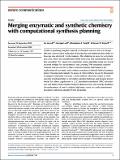Merging enzymatic and synthetic chemistry with computational synthesis planning
Author(s)
Levin, Itai; Liu, Mengjie; Voigt, Christopher A; Coley, Connor W
DownloadPublished version (1.398Mb)
Publisher with Creative Commons License
Publisher with Creative Commons License
Creative Commons Attribution
Terms of use
Metadata
Show full item recordAbstract
<jats:title>Abstract</jats:title><jats:p>Synthesis planning programs trained on chemical reaction data can design efficient routes to new molecules of interest, but are limited in their ability to leverage rare chemical transformations. This challenge is acute for enzymatic reactions, which are valuable due to their selectivity and sustainability but are few in number. We report a retrosynthetic search algorithm using two neural network models for retrosynthesis–one covering 7984 enzymatic transformations and one 163,723 synthetic transformations–that balances the exploration of enzymatic and synthetic reactions to identify hybrid synthesis plans. This approach extends the space of retrosynthetic moves by thousands of uniquely enzymatic one-step transformations, discovers routes to molecules for which synthetic or enzymatic searches find none, and designs shorter routes for others. Application to (-)-Δ<jats:sup>9</jats:sup> tetrahydrocannabinol (THC) (dronabinol) and R,R-formoterol (arformoterol) illustrates how our strategy facilitates the replacement of metal catalysis, high step counts, or costly enantiomeric resolution with more elegant hybrid proposals.</jats:p>
Date issued
2022-12-14Department
Massachusetts Institute of Technology. Department of Biological EngineeringJournal
Nature Communications
Publisher
Springer Science and Business Media LLC
Citation
Levin, Itai, Liu, Mengjie, Voigt, Christopher A and Coley, Connor W. 2022. "Merging enzymatic and synthetic chemistry with computational synthesis planning." Nature Communications, 13 (1).
Version: Final published version